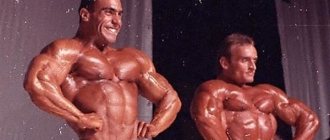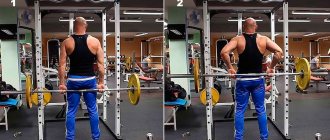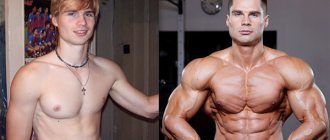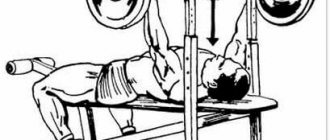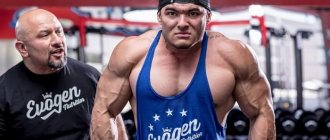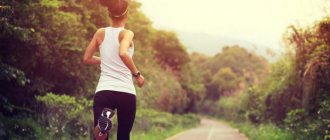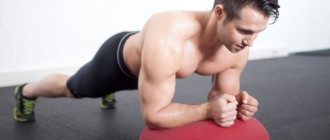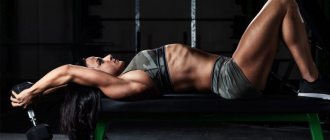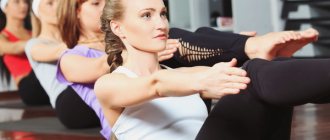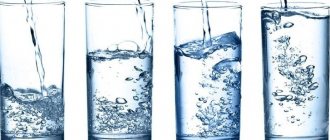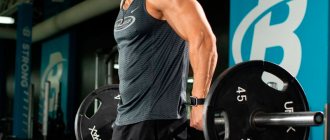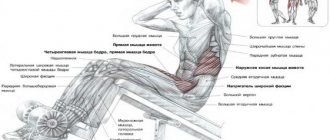Anthropometric data
From the point of view of modern bodybuilding, Sandow's proportions are considered not the most ideal, but they are a kind of standard. And the main indicator of his amazing physical shape is the title of one of the strongest people in history, amazing athletic feats and several strength records.
- Height – 174 cm
- Weight - 92 kg
- Neck – 45 cm
- Biceps – 45 cm
- Chest – 122 cm
- Waist – 80 cm
- Thigh – 66 cm
- Shin – 42 cm
Everyone can compare their physique to the figure of the famous athlete and see that it is possible to achieve excellent shape, relying on genetic capabilities and strength training, without drugs or tricks.
Exercises that make up the Sandow system
| Biceps. Back straight, standing, arms along the body with dumbbells, palms forward. Without moving your elbows, bend your arms at the elbow joint towards your shoulders one by one. |
| Forearm extensors and biceps. The same as in exercise 1, but the palms are turned back, the hands hold the dumbbells with an overhand grip. |
| Biceps, deltoids, triceps. Standing, back straight, arms to the sides, body forming the letter T, palms up. We bend our arms at the elbows one by one, without lowering them. |
| Same as in exercise 3, but we bend our arms at the same time. Bend as you inhale, extend as you exhale. |
| Muscles of the chest, back, shoulder girdle. Standing, arms with dumbbells extended forward at shoulder level, palms facing each other. We spread our arms to the sides while inhaling, back to the i.p. on the exhale. |
| Deltoid, trapezius and triceps muscles of the shoulders. Standing, back straight, looking forward, hands with dumbbells at the shoulders, palms facing each other. Raise your arms horizontally up one at a time. |
| Deltoid muscles. Back slightly bent, hands on hips, overhand grip, palms down. Raise your arms one at a time to shoulder level. |
| Strengthening the wrist joints and forearm muscles. Palms down, arms with dumbbells to the sides. We turn the projectiles with our hands: up - down, forward - back. |
| Same as ex. 8, but we take the dumbbells by one end and rotate the hands forward and backward. |
| We strengthen the muscles of the thigh, back and abs. Stand with your back and legs straight. Hands with dumbbells above your head vertically, palms facing each other. Without bending your knees, bend over, hands touch the floor - exhale. We return to IP. - inhale. |
| Leg and deltoid muscles. Standing, back straight, arms with dumbbells along the body. We bend our right arm so that the forearm is perpendicular to the body, lunge forward with our left leg, while simultaneously straightening our right arm horizontally - exhale. We quickly return to the IP position, moving the elbow back - inhale. Repeat for the left arm and right leg. |
| Deltoid and trapezius muscles. Standing, back straight, arms with dumbbells along the body. We raise both arms simultaneously through the sides up - inhale. We return to IP. - exhale. |
| Muscles of the chest, shoulder girdle, triceps. Push ups. The body from the back of the head to the heels forms a straight line, lying down. Bend your elbows, trying to touch your chest to the floor. We go down as we inhale, we rise as we exhale. |
| Obliques, biceps, deltoids, trapezius. Standing, back straight, arms with dumbbells along the body. As you inhale, bend to the left, while simultaneously raising your right arm so as to bring the dumbbell to your armpit. As you exhale, we return to IP. Repeat to tilt to the right. |
| Abdominal muscles. Lying on your back, the body forms a straight line, arms with dumbbells are extended above the head, continuing the line of the body. The legs are fixed motionless. We sit down with the strength of the abdominal press, without bending our arms, and bend over - hands to the feet as we exhale. We return to i. p. while inhaling. |
| Abdominals and quadriceps muscles. Lying on your back with your hands behind your head. Raise your straight legs to a position perpendicular to the floor as you exhale. We return to IP. while inhaling. |
| Calf and quadriceps muscles of the thigh. Standing straight, arms with dumbbells along the body. We perform a squat until an angle of 90 degrees is formed with the thigh and shin, while simultaneously lifting onto the toes - inhale. We return to IP. - exhale. |
| We strengthen the wrist joints and forearm muscles. Standing, arms with dumbbells along the body. We bend and straighten our hands at the wrist joints. |
The following videos show and explain in sufficient detail all the movements presented.
How to become a participant in Men's Physique competitions?
To get into the beach bodybuilding competition, you need to know when and in what place it will be held. The next step is registration, the completion time of which depends on the level of the competition:
- You can register for a regional event, held in a small city or at the regional level, on the same day it begins.
- For a regional one, if we are talking about a large populated center, you should go through the registration procedure the day before.
- You can participate in the championship, national cup and above only if you have qualifications.
To qualify, you must successfully perform at a regional or regional level tournament. It is usually assigned by the president of the federation or the chief judge.
The competition is held in several stages. First there is a presentation, during which the athletes come out one by one to the judges. The competition then begins with athletes in groups of five demonstrating four different poses. The winners ceremony takes place after all bodybuilders have finished their performances.
If the competition is held at the regional level, participants register before the start. For regional performances, your name is added to the list of participants the day before. For international competitions – “Olympia” and “Arnold Classic” applications can be submitted by professionals who have received the status after successful performances at local competitions.
Read more: I felt bad during training, what to do Everything from A to Z
Michelangelo and Donatello
The first two names that open our list of the 10 most iconic sculptors in the world are well known to all art lovers. We are talking about the outstanding masters of the Renaissance - Donatello and Michelangelo. Both were very productive and created many masterpieces, but their most famous works were perhaps the statues of David. Donatello's sculpture is much older, dating back to 1430-1440.
Well, Michelangelo, who completed his David at the very beginning of the 16th century, managed to create one of the most copied works of art. Only in Florence, where the original is located, two “doubles” were also installed.
A copy is also widely known, which is located on the embankment in Copenhagen. It was donated to the city by brewer Carl Jacobsen in 1896.
Power numbers of Evgeniy Sandov
- His most amazing performance was fighting a lion. The animal was given a muzzle and special bags on its paws so that the predator could not use its claws. The lion rushed at the artist, and he caught him, held him and threw him aside.
- A platform was installed on the athlete’s chest on which stood three horses or an eight-person orchestra with a piano.
- Standing on a handkerchief, he held 27 kg in each hand and did somersaults with them, landing on the same handkerchief.
- Hanging in the air between two chairs, with support on the back of his head and heels, he could hold two people on his own body, like on a bridge, while holding 22 kg in each on his outstretched arms.
- He lifted and pressed a barbell weighing 115 kg, transferred it to the other hand, did a squat, lay on his back, holding the apparatus at arm's length above his head, then easily rose to his feet.
Stepan Erzya
Obeying logic, we should now talk about the great sculptor, whom the press dubbed “Russian Rodin” - Stepan Erzya. He went down in history not only thanks to his artistic talent, but also because he worked with an unusual material - kebracho. Having spent most of his creative life in Argentina, the master fell in love with this stubborn tree, whose name literally translates as “break the axe.”
Erzya is also famous for its large-scale projects to transform mountains into monuments. But he failed to implement them.
Athleticism in Russia[edit | edit code]
In pre-revolutionary Russia, strength sports were no less popular. The famous athlete and promoter of athleticism, journalist and writer Ivan Lebedev (Uncle Vanya) turned the French wrestling championships into vibrant theatrical spectacles. Wrestling and athletic performances were accompanied by music. Russian and foreign wrestlers took part in the competition, one of whom traditionally performed in a mask, and intrigued spectators tried to guess who was hiding under it this time. Any person from the public could challenge this or that celebrity to a duel, and it happened that the amateur would win.
Athleticism. Explanatory Video Dictionary
Wrestling competitions and athletic performances took place in the luxurious St. Petersburg circus "Modern" and the garden of the Society for the Guardianship of People's Temperance, in the city theaters of Odessa and Stavropol, in the parks of Penza and Orenburg, in numerous booths that traveled throughout Russia.
They were attended by the Estonian heroes Georg Gakkenshmidt, Georg Lurich, Alex Aberg, the Kazakh strongman Hadji-Mukhan, the Caucasians Kosta Maisuradze and Sali Suleiman, the famous Ivan Poddubny, the King of Kettlebells Peter Krylov, Ivan Shemyakin and Nikolai Vakhturov, the strongman from Siberia Terenty Koren and Vyatsky giant peasant Grigory Kashcheev. The Hungarian Janos Czaja and the Pole Stanislav Zbyszko-Tsyganevich, the Frenchman Raoul Le Boucher and the Dutchman Van Riel, the black Bambula and other foreigners who became famous in Russia appeared in the arena. A jury of the public and representatives of the sports community determined the winners of the fights on the mat.
Winston Churchill was present at Zass's speech in England. The photographer captured the Prime Minister on a platform with people, which the hero raises.
At the end of the championship, after the presentation of cash prizes and medals, there was often a beauty contest for the male body, in which professionals and amateurs took part. Even then, Russian athletes attached great importance not only to the development of muscle strength, but also to the formation of a beautiful figure.
Many outstanding cultural and artistic figures were passionate fans of French wrestling and were themselves passionate about sports.
Fyodor Chaliapin was engaged in athletic exercises. Alexander Green wrote a story specifically for the Hercules magazine, “And Spring Will Come for Me,” about the fate of the circus wrestler Thomas Sibiryak, whose prototype, in all likelihood, was the famous athlete and wrestler Emil Foss. The humorist writer Averchenko was involved in weightlifting, and some of his stories are dedicated to sports.
A huge contribution to the development of Russian athletics was made by the doctor Vladislav Frantsevich Kraevsky, who lived in St. Petersburg at the end of the 19th century. A Pole by nationality, he graduated from the medical faculties of Warsaw and Berlin universities. In 1885, on August 10, he founded the first circle of athletics enthusiasts in Russia. Kraevsky decided to organize it after he saw the performance of the professional German athlete Charles Ernest in the zoological garden, lifting weights and demonstrating excellent muscles.
Traveling around Europe, he became acquainted with the development of physical education and sports in Austria-Hungary, Germany, Italy, and Spain. Returning to Russia, Kraevsky organized lectures and demonstration performances by foreign athletes. In his apartment, he opened an athletic hall where both amateurs and professionals could train.
The hall was perfectly equipped: the floor was covered with a soft carpet, on which it was comfortable for the wrestlers to train, a variety of barbells, bulldogs, dumbbells, weights were placed on special shelves, the walls were hung with hundreds of photographs of athletes and wrestlers from all countries.
The founding date of this circle is considered the birthday of Russian weightlifting, and Kraevsky is considered the “father of Russian athletics.” He once expressed a thought that was destined to come true 100%:
“I am sure that weightlifting has a great future in Russia. It seems to me that such a mass of exceptionally strong people does not exist in any other country.”
Kraevsky outlined his thoughts on the basics of athletic sports in the manuscript “Catechism of an Athlete. Rules for those involved in sports." The manuscript was approved by the censor, but was never published. The author considered physical development, health and hardening of the body to be the basis of athletic sports. The Catechism outlined the methodology for teaching athletics and training teachers.
On the initiative of Count Georgy Ivanovich Ribopierre, the St. Petersburg Athletic Society was opened on January 30, 1897. In the same year, the first Russian weightlifting championship was held. Numerous athletic clubs and athletic studios began to appear in other cities. Sports magazines begin to be published: “Sport”, “Russian Sport”, “To Sports”, “Hercules”. The most popular systems of physical development are translated into Russian: “Strength and how to become strong” by Sandow, “My System” by Muller, “Exercise with Weights” by Garrison, “Body Culture” by Edwards.
Among the athletes and wrestlers of the past there were many absolutely amazing personalities. Dr. A.K. Anokhin (pseudonym - B. Ross) is the author of “Volitional Gymnastics” and numerous articles on hygiene and physical development. Alexander Zass (Samson) created several systems of physical development, invented the hand dynamometer and was an excellent trainer. Ludwig Chaplinsky is the founder of the Sanitas sports society, chairman of the All-Russian Weightlifting Union, and author of numerous articles on sports. Georg Lurich is a wonderful chess player and pianist who speaks 10 languages. Yakuba Chekhovskaya is the vice-chairman of the All-Russian Wrestling Union, one of the founders of the first Soviet sports magazine “Wrestler-Athlete”. Pyotr Krylov is a long-distance navigator and a passionate promoter of athleticism. Ivan Zaikin is one of the first Russian aviators.
In 1908, a weightlifting league was created in St. Petersburg, which led the work of all Russian circles and clubs, and in 1913, the first All-Russian Weightlifting Union was formed there, headed by the owner of two world records, L. A. Chaplinsky. Weightlifting then included weight lifting, wrestling, boxing, tug of war, throwing weights, pushing stones. In weight lifting, records were recorded in 11 exercises, including the bench press and squats. In the same year, Russia joined the World Weightlifting Union.
Training principles
In his activities, Sandow wanted to combine the achievements of scientific thought and the ancient Greek ideal, expressed in the concept of “kalos kai hagatos”, which meant “beautiful and good”. This concept was supposed to convey the unity of the physical and mental principles, the harmony of the two components. The desire for a healthy, strong body was simultaneously supposed to strengthen the spirit and improve the human soul.
The athlete emphasized the importance of attitude towards his body, not considering the physical principle as opposed to the spiritual. In his work, Eugene adhered to the same revolutionary principle of training that his mentor, Professor Attila, once proposed. Progressive resistance training now seems like the most natural and correct way to build an athletic physique and strengthen muscles, but this was not always the case. At the end of the 19th century, high power loads were considered dangerous. Even among professionals, there was an opinion that heavy weights would lead to muscle tears, injuries to the bone structure, and even death. Attila, and then Sandow, using the example of many athletes, proved that a gradual increase in load will not lead to negative consequences. Evgeniy also developed a method of training with progressive resistance, which helps to cope with a person’s natural limitation in increasing weights, because he is not able to do this indefinitely. Then another type of load and alternation of methods takes over.
Ernst Neizvestny
A cult figure in the history of Soviet art is undoubtedly Ernst Neizvestny, a representative of “degenerate art,” as Nikita Khrushchev called him. Such an assessment greatly complicated the life and work of the master. However, after Khrushchev’s death, Neizvestny generously agreed to fulfill the request of his relatives and create a tombstone for the politician.
The most famous works of the sculptor are “Orpheus” (1962), the monumental composition “Prometheus and the Children of the World” (1966), created in Artek, “Mask of Sorrow” (1996) - a 30-meter memorial to the victims of political repression.
Bodymaster.ru recommends Fitness Trainers:
Could lift a barbell weighing 122 kg with one hand.
Did up to 200 push-ups in 4 minutes.
He held 27kg weights on his arms outstretched forward for several seconds.
Holding a 24-kilogram weight in each hand, he stood on a handkerchief, then jumped and did a backflip, landing exactly there.
Leaning his heels on one chair and the back of his head on another, he held two people on his chest and a 22-kilogram weight in his outstretched hand.
